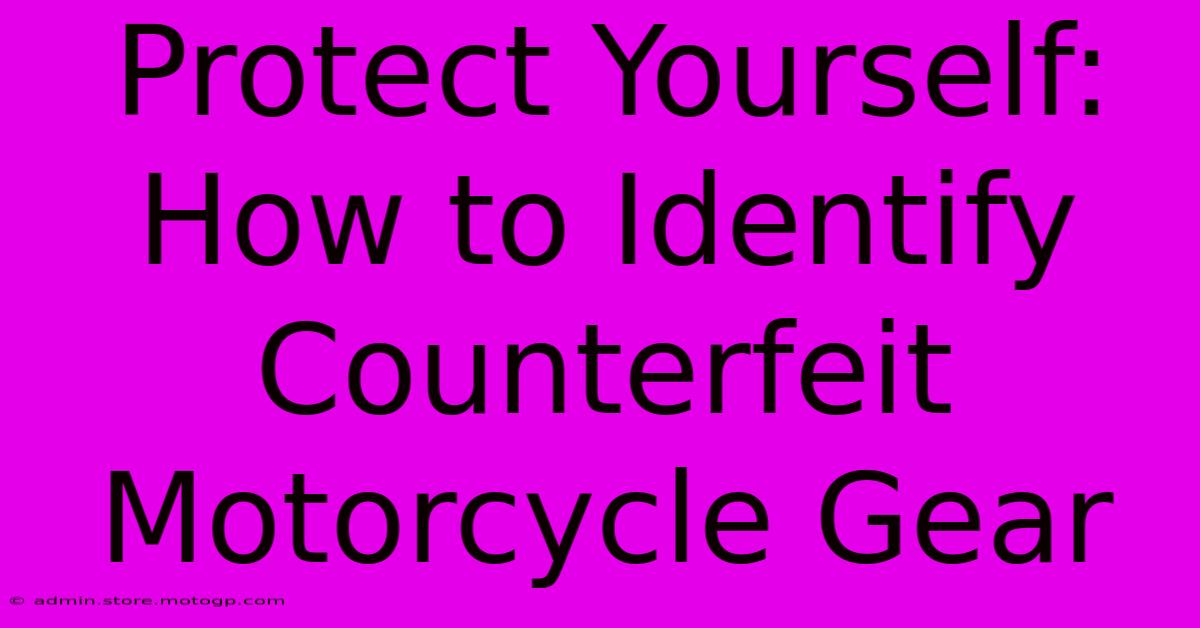Protect Yourself: How To Identify Counterfeit Motorcycle Gear

Table of Contents
Protect Yourself: How to Identify Counterfeit Motorcycle Gear
Riding a motorcycle is exhilarating, but it's also inherently risky. Your gear is your first line of defense, and trusting in its protective capabilities is paramount. Unfortunately, the market is flooded with counterfeit motorcycle gear, posing a significant threat to your safety. These fakes often look the part but lack the crucial protective qualities of genuine products, leaving you vulnerable in a crash. This guide will equip you with the knowledge to identify counterfeit motorcycle gear and protect your investment – and most importantly, your life.
The Dangers of Counterfeit Motorcycle Gear
The consequences of wearing counterfeit motorcycle gear can be devastating. Counterfeit helmets, for instance, may fail to meet safety standards, offering significantly reduced protection in an impact. This could lead to:
- Severe head injuries: A poorly constructed helmet might shatter or deform improperly upon impact, increasing the risk of skull fractures, brain damage, and even death.
- Increased injury severity: Fake jackets, pants, and gloves often use inferior materials, lacking the abrasion resistance and impact protection of genuine products. This increases the risk of road rash, fractures, and other injuries.
- False sense of security: The biggest danger is the deceptive appearance. You believe you're protected, but you're not. This false sense of security can have fatal consequences.
How to Spot a Fake: Key Identifying Factors
Identifying counterfeit gear requires a keen eye and a methodical approach. Here are some key areas to examine:
1. Price: Is it Too Good to Be True?
Significantly lower prices than authorized retailers are a major red flag. Genuine motorcycle gear is expensive because of the high-quality materials and rigorous testing involved. If a deal seems too good to be true, it probably is.
2. Packaging and Labeling: Check for Inconsistencies
Examine the packaging carefully. Look for inconsistencies like poor printing quality, misspellings, or incorrect logos. Compare the packaging to images of genuine products found on the manufacturer's official website.
3. Materials and Construction: Feel the Difference
Genuine gear uses high-quality materials. Feel the fabric and stitching. Counterfeits often use cheap, thin materials with loose or uneven stitching. Look for inconsistencies in the materials used throughout the garment.
4. Safety Certifications and Labels: Verify Authenticity
Look for safety certifications like ECE 22.05 (for helmets) or CE markings (for other gear). These certifications indicate that the product has passed rigorous safety testing. Counterfeits often display fake or altered certifications. Check the manufacturer's website to verify the authenticity of the certification labels.
5. Stitching Quality: Examine Closely
High-quality stitching is a hallmark of genuine gear. Examine the stitching closely for inconsistencies, loose threads, or skipped stitches. Poor stitching is a common indicator of a counterfeit product.
6. Zippers and Fasteners: Test Functionality
Test the zippers and other fasteners. Genuine gear uses durable zippers and fasteners. If the zippers stick, jam, or break easily, it's a sign of inferior quality.
7. Logos and Branding: Subtle Differences Matter
Examine the logos and branding closely. Counterfeits often have subtle differences in logos, fonts, or placement. Compare them to images of genuine products found on the manufacturer's website.
8. Seller Reputation: Buy from Reputable Sources
Always buy from authorized dealers or reputable online retailers. Avoid purchasing from unknown sellers on auction sites or social media platforms. Check reviews and ratings before making a purchase.
Protecting Yourself: A Summary of Best Practices
- Buy from authorized retailers: This ensures the authenticity of your gear.
- Verify certifications: Check for legitimate safety labels.
- Inspect the product thoroughly: Pay close attention to details.
- Compare prices: Be wary of unusually low prices.
- Read reviews: See what other customers have to say.
Wearing counterfeit motorcycle gear is a gamble you cannot afford to take. Your safety depends on the quality and integrity of your protective equipment. By following these guidelines, you can significantly reduce the risk of purchasing counterfeit gear and protect yourself on the road. Remember, your life is worth the investment in genuine safety gear.

Thank you for visiting our website wich cover about Protect Yourself: How To Identify Counterfeit Motorcycle Gear. We hope the information provided has been useful to you. Feel free to contact us if you have any questions or need further assistance. See you next time and dont miss to bookmark.
Featured Posts
-
The Best Of Austin Gp Concert
Feb 18, 2025
-
Navigate Cota Parking Like A Pro
Feb 18, 2025
-
Safety Meets Style Moto Gp Replica Helmets
Feb 18, 2025
-
Top Motorcycle Races You Need To Know
Feb 18, 2025
-
Breathing Easy Ventilation In Moto Gp Helmets
Feb 18, 2025
